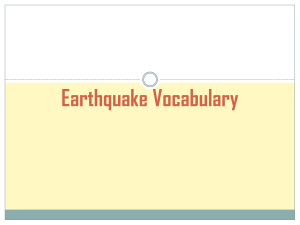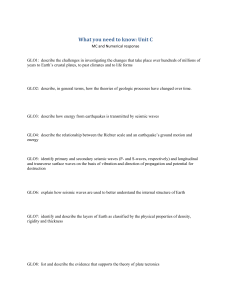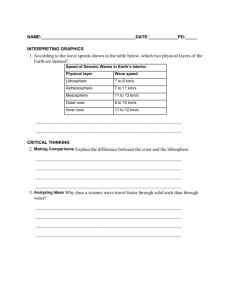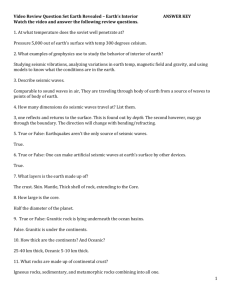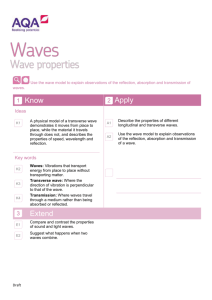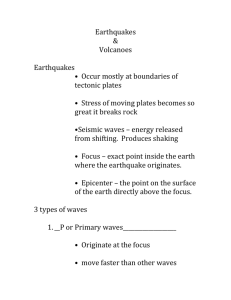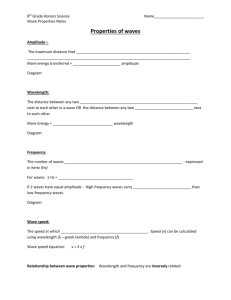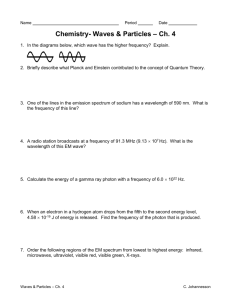Seismic Wave
advertisement
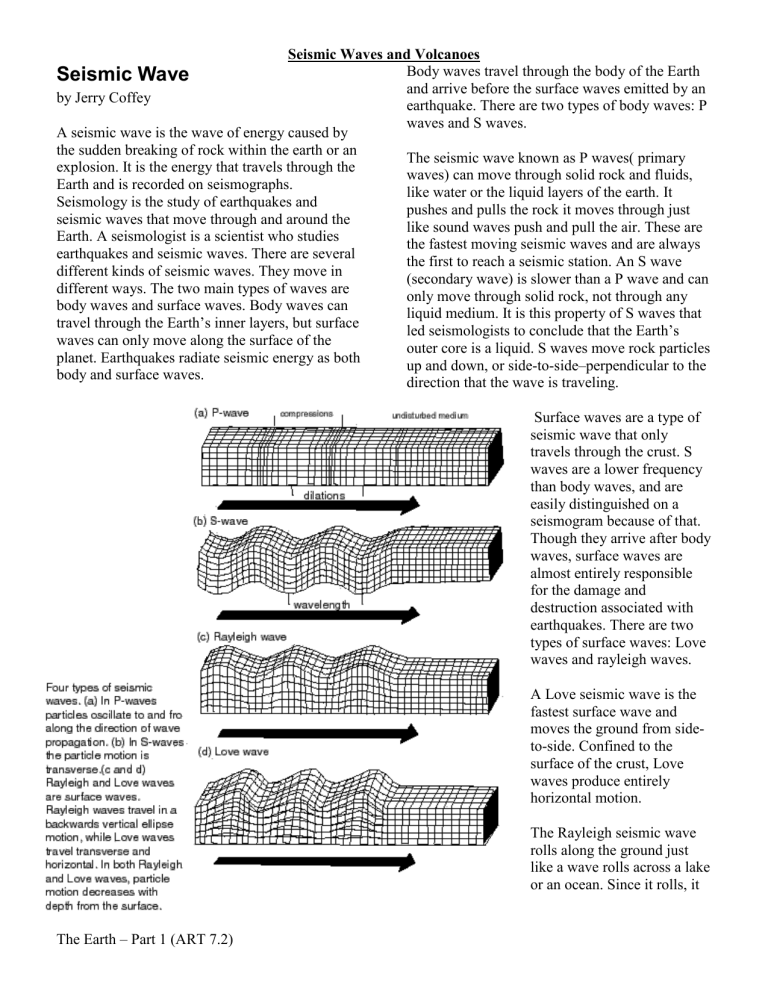
Seismic Waves and Volcanoes Body waves travel through the body of the Earth Seismic Wave and arrive before the surface waves emitted by an by Jerry Coffey earthquake. There are two types of body waves: P waves and S waves. A seismic wave is the wave of energy caused by the sudden breaking of rock within the earth or an The seismic wave known as P waves( primary explosion. It is the energy that travels through the waves) can move through solid rock and fluids, Earth and is recorded on seismographs. like water or the liquid layers of the earth. It Seismology is the study of earthquakes and pushes and pulls the rock it moves through just seismic waves that move through and around the like sound waves push and pull the air. These are Earth. A seismologist is a scientist who studies the fastest moving seismic waves and are always earthquakes and seismic waves. There are several the first to reach a seismic station. An S wave different kinds of seismic waves. They move in (secondary wave) is slower than a P wave and can different ways. The two main types of waves are only move through solid rock, not through any body waves and surface waves. Body waves can liquid medium. It is this property of S waves that travel through the Earth’s inner layers, but surface led seismologists to conclude that the Earth’s waves can only move along the surface of the outer core is a liquid. S waves move rock particles planet. Earthquakes radiate seismic energy as both up and down, or side-to-side–perpendicular to the body and surface waves. direction that the wave is traveling. Surface waves are a type of seismic wave that only travels through the crust. S waves are a lower frequency than body waves, and are easily distinguished on a seismogram because of that. Though they arrive after body waves, surface waves are almost entirely responsible for the damage and destruction associated with earthquakes. There are two types of surface waves: Love waves and rayleigh waves. A Love seismic wave is the fastest surface wave and moves the ground from sideto-side. Confined to the surface of the crust, Love waves produce entirely horizontal motion. The Rayleigh seismic wave rolls along the ground just like a wave rolls across a lake or an ocean. Since it rolls, it The Earth – Part 1 (ART 7.2) Seismic Waves and Volcanoes moves the ground up and down, and side-to-side Subduction-created magma rises into the lower in the same direction that the wave is moving. crust, where it collects and occasionally erupts Most of the shaking felt from an earthquake is due vigorously, even explosively. The geometry of subduction means that volcanoes tend to appear in to the Rayleigh wave. long arcs. Volcanism in a Nutshell By Andrew Alden Volcanism is the eruption of material from deep in the Earth. In many cases, eruptions build up a pile of material, a mountain that is called a volcano. But here I'll discuss volcanism, because most eruptions don't build volcanoes. This is a highly simplified treatment of an intricate subject. Four types of magmatic volcanism The third type of volcanism covers the small fraction of volcanoes, about 10 percent, in places that aren't related to divergent or convergent margins. These are lumped together as hotspot volcanoes. There are two schools of thought about hotspots. The majority of geologists consider hotspots to arise from very deep in the mantle, in rising plumes of hot material. A minority has a newer theory involving fracturing of the lithospheric plates, in which magmas form much as they do in divergent settings. The majority of Earth's volcanism happens underwater at the midocean ridges, or, in platetectonic language, at divergent margins. The crust is pulled apart, and the hot rock in the mantle beneath begins to melt as the pressure upon it is released. Its temperature doesn't change, only the pressure. The part that melts—the magma—rises while the rest of the mantle rock stays behind. The two parts have different compositions: the magma is basalt and what remains is peridotite, a heavier rock that is largely olivine. The fourth type is not occurring today, but has happened in recent geologic history. It is flood volcanism, in which enormous amounts of basalt lava pour out of fissures and cover areas of thousands of square kilometers. Flood basalts appear both on land (for example the Columbia River Basalts and the Deccan Traps) and under the sea (the Ontong Java Plateau, Kerguelen Plateau, and more). These are under intense study but remain a major unsolved problem in geology. This kind of volcanism is mostly a quiet oozing of basalt lava out of long cracks in the seafloor. Seafloor fissure eruptions have been filmed from research submarines. There are a few divergent margins on land, and volcanism there is very different from the oceanic case. Products of volcanism The second type of volcanism happens in association with subduction zones, places where oceanic plates laden with water and sediment plunge into the hot mantle. It is responsible for building most of the world's volcanoes. Fluids that are driven off the descending plates rise into the upper, overriding plate where they promote the formation of magma. Notice that in this case magma is created by adding water to mantle rock, not by releasing pressure on it. The Earth – Part 1 (ART 7.2) Volcanism recycles the material that goes through plate tectonics. To a first approximation, everything that is subducted returns to the surface Seismic Waves and Volcanoes in magma. When magma is erupted—that is, Nonmagmatic volcanism when magma becomes lava—it returns solids, There are less well-known types of volcanism that fluids and gases to the Earth's crust and surface. don't involve magma: mud volcanism is one. Mud volcanoes come in two types. On land, hundreds The solids are igneous rocks, ready to enter the of them occur in areas where hydrocarbons are rock cycle. They may be flows of lava that cool abundant, like Trinidad or Azerbaijan. Under the into thick layers of hard rock, or shattered sea, thousands of them occur near subduction fragments of volcanic ash. Either way, the trenches, where serpentinite mud is abundant. minerals of igneous rocks become available to turn into sedimentary and metamorphic rocks. Another newly discovered form of volcanism involves asphalt. Asphalt, or tar, flows were first The fluids act underground. As they rise magmas documented on the floor of the Gulf of Mexico in release water, which incorporates with it dissolved 2003. No one knows how many of these tar silica, metals and other elements in a chemically volcanoes there are. active mix. These magmatic fluids can alter the rocks around them and deposit bodies of ore and sulfate minerals. The gases are what cause lava to erupt. Just as bubbles form in an opened can of soft drink, so do sulfur gases, carbon dioxide, and water vapor in rising magma. The result is that rising magma expands, and this in turn makes it rise faster. The gases leave the lava and enter the atmosphere, where they influence its composition and affect the global climate in various ways. The Earth – Part 1 (ART 7.2)
